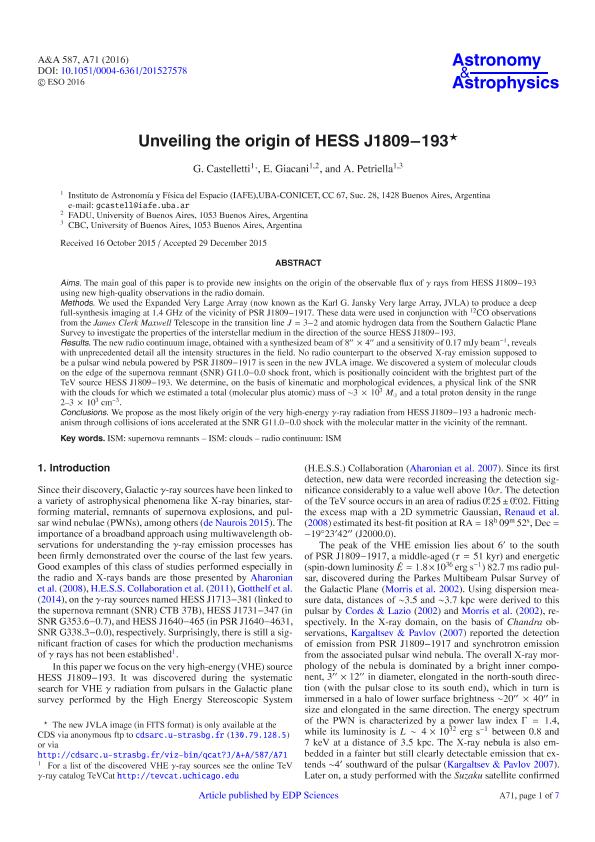Mostrar el registro sencillo del ítem
dc.contributor.author
Castelletti, Gabriela Marta

dc.contributor.author
Giacani, Elsa Beatriz

dc.contributor.author
Petriella, Alberto

dc.date.available
2017-07-28T20:32:37Z
dc.date.issued
2016-03
dc.identifier.citation
Castelletti, Gabriela Marta; Giacani, Elsa Beatriz; Petriella, Alberto; Unveiling the origin of HESS J1809-193; EDP Sciences; Astronomy and Astrophysics; 587; A71; 3-2016; 1-7
dc.identifier.issn
0004-6361
dc.identifier.uri
http://hdl.handle.net/11336/21594
dc.description.abstract
Aims: The main goal of this paper is to provide new insights on the origin of the observable flux of γ rays from HESS J1809-193 using new high-quality observations in the radio domain. Methods: We used the Expanded Very Large Array (now known as the Karl G. Jansky Very large Array, JVLA) to produce a deep full-synthesis imaging at 1.4 GHz of the vicinity of PSR J1809-1917. These data were used in conjunction with 12CO observations from the James Clerk Maxwell Telescope in the transition line J = 3-2 and atomic hydrogen data from the Southern Galactic Plane Survey to investigate the properties of the interstellar medium in the direction of the source HESS J1809-193. Results: The new radio continuum image, obtained with a synthesized beam of 8´´ × 4´´ and a sensitivity of 0.17 mJy beam-1, reveals with unprecedented detail all the intensity structures in the field. No radio counterpart to the observed X-ray emission supposed to be a pulsar wind nebula powered by PSR J1809-1917 is seen in the new JVLA image. We discovered a system of molecular clouds on the edge of the supernova remnant (SNR) G11.0-0.0 shock front, which is positionally coincident with the brightest part of the TeV source HESS J1809-193. We determine, on the basis of kinematic and morphological evidences, a physical link of the SNR with the clouds for which we estimated a total (molecular plus atomic) mass of ~3 × 103M⊙ and a total proton density in the range 2-3 × 103 cm-3. Conclusions: We propose as the most likely origin of the very high-energy γ-ray radiation from HESS J1809-193 a hadronic mechanism through collisions of ions accelerated at the SNR G11.0-0.0 shock with the molecular matter in the vicinity of the remnant.
dc.format
application/pdf
dc.language.iso
eng
dc.publisher
EDP Sciences

dc.rights
info:eu-repo/semantics/openAccess
dc.rights.uri
https://creativecommons.org/licenses/by-nc-sa/2.5/ar/
dc.subject
Ism: Supernova Remnants
dc.subject
Ism: Clouds
dc.subject
Radio Continuum:Ism
dc.subject.classification
Astronomía

dc.subject.classification
Ciencias Físicas

dc.subject.classification
CIENCIAS NATURALES Y EXACTAS

dc.title
Unveiling the origin of HESS J1809-193
dc.type
info:eu-repo/semantics/article
dc.type
info:ar-repo/semantics/artículo
dc.type
info:eu-repo/semantics/publishedVersion
dc.date.updated
2017-07-27T12:49:22Z
dc.journal.volume
587
dc.journal.number
A71
dc.journal.pagination
1-7
dc.journal.pais
Francia

dc.journal.ciudad
Paris
dc.description.fil
Fil: Castelletti, Gabriela Marta. Consejo Nacional de Investigaciónes Científicas y Técnicas. Oficina de Coordinación Administrativa Ciudad Universitaria. Instituto de Astronomía y Física del Espacio. - Universidad de Buenos Aires. Facultad de Ciencias Exactas y Naturales. Instituto de Astronomía y Física del Espacio; Argentina
dc.description.fil
Fil: Giacani, Elsa Beatriz. Consejo Nacional de Investigaciónes Científicas y Técnicas. Oficina de Coordinación Administrativa Ciudad Universitaria. Instituto de Astronomía y Física del Espacio. - Universidad de Buenos Aires. Facultad de Ciencias Exactas y Naturales. Instituto de Astronomía y Física del Espacio; Argentina
dc.description.fil
Fil: Petriella, Alberto. Consejo Nacional de Investigaciónes Científicas y Técnicas. Oficina de Coordinación Administrativa Ciudad Universitaria. Instituto de Astronomía y Física del Espacio. - Universidad de Buenos Aires. Facultad de Ciencias Exactas y Naturales. Instituto de Astronomía y Física del Espacio; Argentina
dc.journal.title
Astronomy and Astrophysics

dc.relation.alternativeid
info:eu-repo/semantics/altIdentifier/doi/http://dx.doi.org/10.1051/0004-6361/201527578
dc.relation.alternativeid
info:eu-repo/semantics/altIdentifier/url/https://www.aanda.org/articles/aa/abs/2016/03/aa27578-15/aa27578-15.html
dc.relation.alternativeid
info:eu-repo/semantics/altIdentifier/url/https://arxiv.org/pdf/1601.04962.pdf
Archivos asociados
